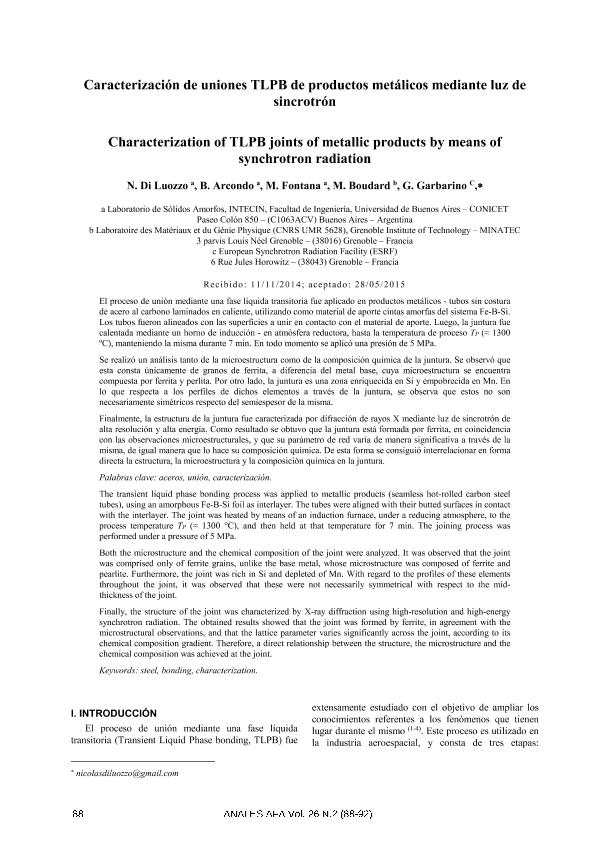Artículo
El proceso de unión mediante una fase líquida transitoria fue aplicado en productos metálicos - tubos sin costura de acero al carbono laminados en caliente, utilizando como material de aporte cintas amorfas del sistema Fe-B-Si. Los tubos fueron alineados con las superficies a unir en contacto con el material de aporte. Luego, la juntura fue calentada mediante un horno de inducción - en atmósfera reductora, hasta la temperatura de proceso TP (≈ 1300 ºC), manteniendo la misma durante 7 min. En todo momento se aplicó una presión de 5 MPa. Se realizó un análisis tanto de la microestructura como de la composición química de la juntura. Se observó que esta consta únicamente de granos de ferrita, a diferencia del metal base, cuya microestructura se encuentra compuesta por ferrita y perlita. Por otro lado, la juntura es una zona enriquecida en Si y empobrecida en Mn. En lo que respecta a los perfiles de dichos elementos a través de la juntura, se observa que estos no son necesariamente simétricos respecto del semiespesor de la misma. Finalmente, la estructura de la juntura fue caracterizada por difracción de rayos X mediante luz de sincrotrón de alta resolución y alta energía. Como resultado se obtuvo que la juntura está formada por ferrita, en coincidencia con las observaciones microestructurales, y que su parámetro de red varía de manera significativa a través de la misma, de igual manera que lo hace su composición química. De esta forma se consiguió interrelacionar en forma directa la estructura, la microestructura y la composición química en la juntura. The transient liquid phase bonding process was applied to metallic products (seamless hot-rolled carbon steel tubes), using an amorphous Fe-B-Si foil as interlayer. The tubes were aligned with their butted surfaces in contact with the interlayer. The joint was heated by means of an induction furnace, under a reducing atmosphere, to the process temperature TP (≈ 1300 °C), and then held at that temperature for 7 min. The joining process was performed under a pressure of 5 MPa. Both the microstructure and the chemical composition of the joint were analyzed. It was observed that the joint was comprised only of ferrite grains, unlike the base metal, whose microstructure was composed of ferrite and pearlite. Furthermore, the joint was rich in Si and depleted of Mn. With regard to the profiles of these elements throughout the joint, it was observed that these were not necessarily symmetrical with respect to the mid-thickness of the joint. Finally, the structure of the joint was characterized by X-ray diffraction using high-resolution and high-energy synchrotron radiation. The obtained results showed that the joint was formed by ferrite, in agreement with the microstructural observations, and that the lattice parameter varies significantly across the joint, according to its chemical composition gradient. Therefore, a direct relationship between the structure, the microstructure and the chemical composition was achieved at the joint.
Caracterización de uniones TLPB de productos metálicos mediante luz de sincrotrón
Título:
Characterization of TLPB joints of metallic products by means of synchrotron radiation
Di Luozzo, Nicolás ; Arcondo, Bibiana Graciela; Fontana, Marcelo
; Arcondo, Bibiana Graciela; Fontana, Marcelo ; Boudard, Miguel Santiago; Garbarino, Gaston Leonel
; Boudard, Miguel Santiago; Garbarino, Gaston Leonel
 ; Arcondo, Bibiana Graciela; Fontana, Marcelo
; Arcondo, Bibiana Graciela; Fontana, Marcelo ; Boudard, Miguel Santiago; Garbarino, Gaston Leonel
; Boudard, Miguel Santiago; Garbarino, Gaston Leonel
Fecha de publicación:
06/2015
Editorial:
Asociación Física Argentina
Revista:
Anales AFA
ISSN:
0327-358X
e-ISSN:
1850-1168
Idioma:
Español
Tipo de recurso:
Artículo publicado
Clasificación temática:
Resumen
Palabras clave:
Aceros
,
Unión
,
Caracterización
Archivos asociados
Licencia
Identificadores
Colecciones
Articulos(INTECIN)
Articulos de INST.D/TEC.Y CS.DE LA ING."HILARIO FERNANDEZ LONG"
Articulos de INST.D/TEC.Y CS.DE LA ING."HILARIO FERNANDEZ LONG"
Citación
Di Luozzo, Nicolás; Arcondo, Bibiana Graciela; Fontana, Marcelo; Boudard, Miguel Santiago; Garbarino, Gaston Leonel; Caracterización de uniones TLPB de productos metálicos mediante luz de sincrotrón; Asociación Física Argentina; Anales AFA; 26; 2; 6-2015; 88-92
Compartir



